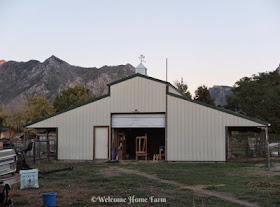I really like it when you ask questions because that helps me know what kinds of things to write about.
 |
| We get this question a lot! No, we do not have pigs. Pigs are not allowed in Highland. Some people think they are too smelly, and too noisy. |
 |
| Sometimes we find garden snakes! When I was cleaning out the chicken pen I found this little snake under the nesting box where the chickens lay their eggs. |
 |
| We get this question a lot, too! We don't have horses. Our neighbor has horses. |
 |
| This is Carson. He says hi to us every morning. He likes the cow and the goats, too. He likes to race our dogs up and down the fence row. He is a very fast horse! |
 |
| Thank you! We think our chickens are cool, too. I think they are funny to watch in the barn yard. |
 |
| Yes, I can show you a video of the chickens. |
This is what happens every morning when I open up the chicken pen.
How many chickens did you see?
 |
| How many gallons of milk do you see in the fridge? |
We milk Echo and the goats every day. It doesn't matter if it's cold or hot or raining or sunny. It doesn't matter if it's Christmas Day or New Years Day. It doesn't matter if we are tired because we stayed up late. We milk every day!
Thank you again for asking good questions! I hope you ask me more good questions. I would like to answer a question every week for you.
Here are some things to remember about asking questions:
- I will only answer a question once. If someone asks the same question, I won't answer it.
- Write clearly because if I can't read the question, I won't be able to answer it.
I hope you have a wonderful Christmas Break.
Remember to
Do something kind
for someone else
every day!





















